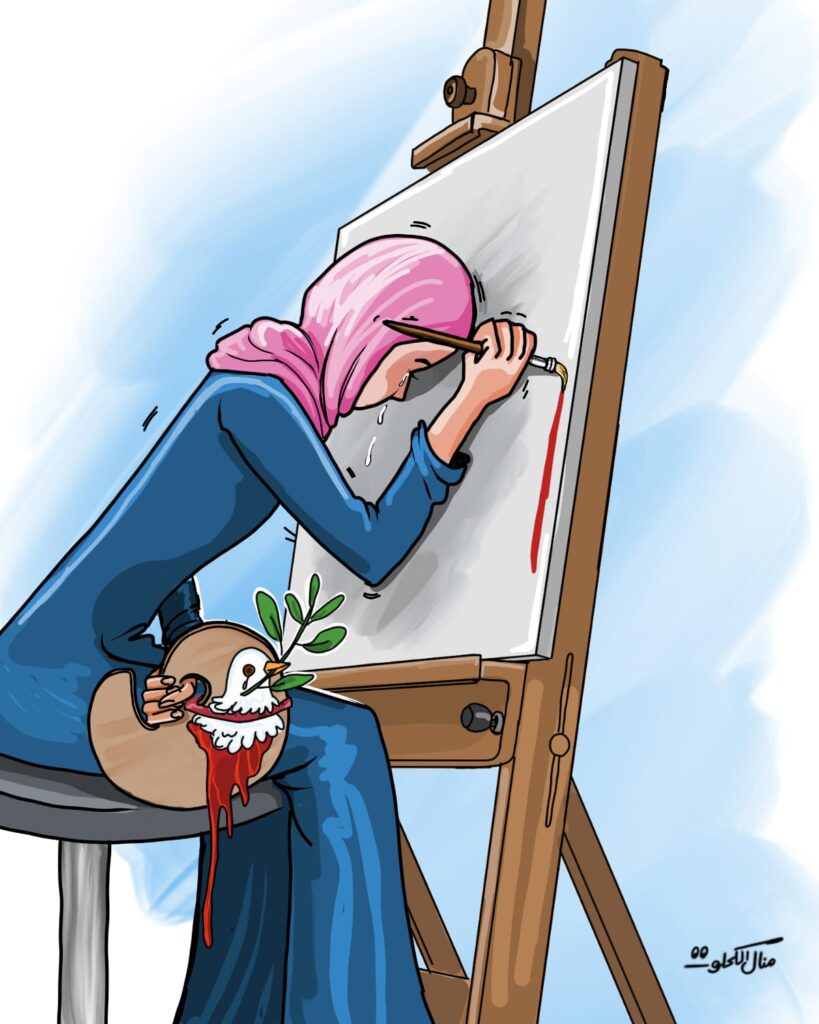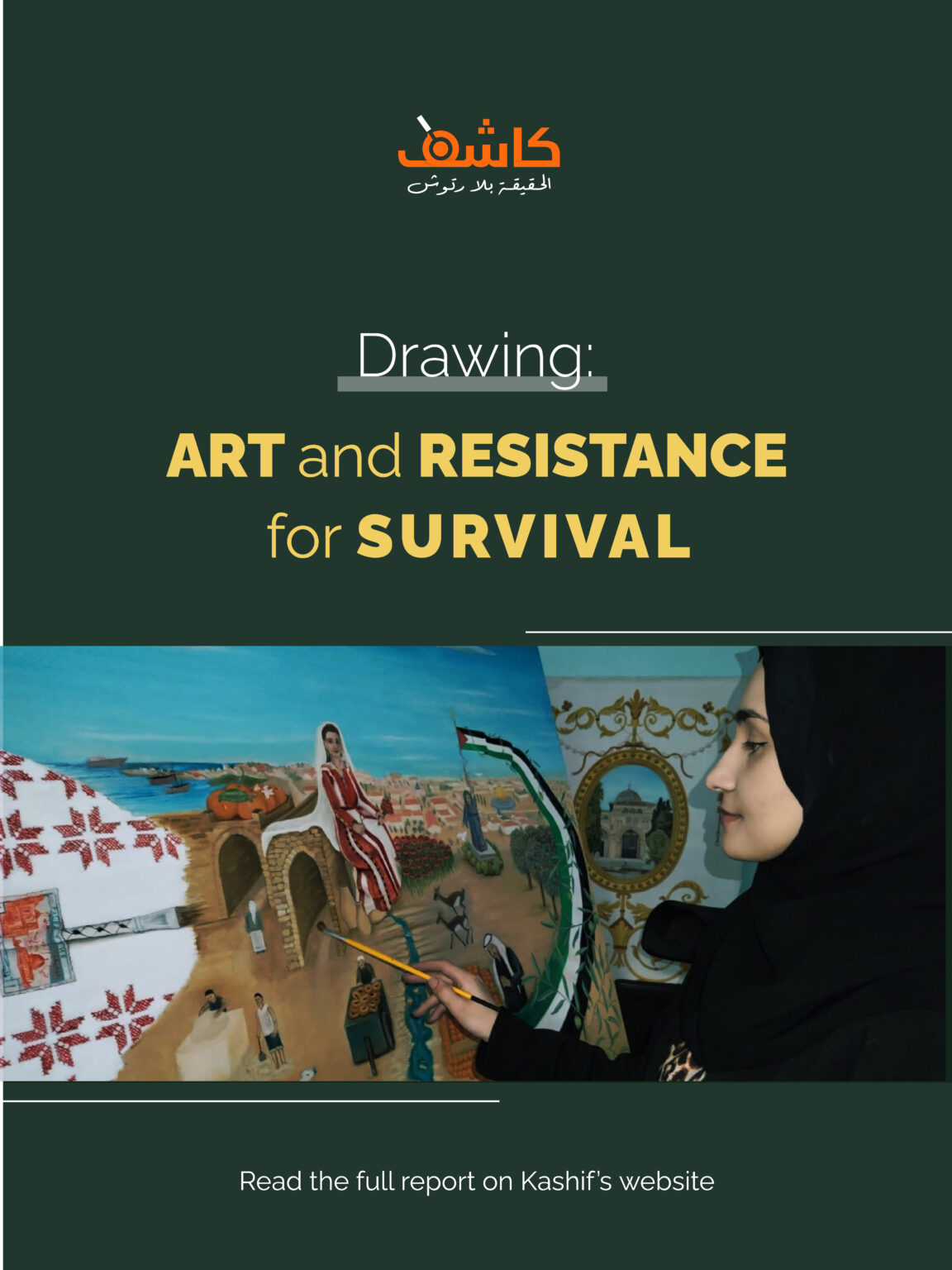Ahlam Hammad – Gaza
Amid complex humanitarian and security circumstances, artist Manal Al-Kahlout possessed the courage and conviction that enabled her to continue working and creating artworks that document the pain, reveal the truth, and champion the victims.
Al-Kahlout, 35-year-old, and her family have been forced to flee five times since the outbreak of the Israeli aggression on the Gaza Strip on 7 October 2023. All of these displacements were from one place to another in the northern half of the Strip, and they did not move south like the majority of the population.
Al-Kahlout suffered greatly during the raging war in her second year, but it motivated her to excel and prove herself, even in the darkest circumstances she faced. She says, “We are all in a constant state of flight from death, and a never-ending race for survival. We run until we sometimes forget our own names. The dire circumstances leave us no room to return to ourselves, but we still yearn for it. We try to hold on to what remains of us and face challenges with hearts that remain undefeated despite everything.”
“As an artist and cartoonist, I drew what I felt, what moved me inside, and what left an indelible mark on people’s memories. I remember vividly drawing many works under fire, living in an area that witnessed invasions, sieges, and starvation. I drew amidst the sounds of shelling and bullets, hearing the echo of tanks approaching, not just from where I was, but from my body and soul,” says Al-Kahlout.
harsh experiences
Al-Kahlout sanctifies the “Palestinian body,” highlighting it prominently in her paintings. In her opinion, “the human body in Gaza represents a symbol of defiance and the love of life. It has endured much pain, not only during this unprecedented war, but also over the past two decades of suffocating siege and repeated wars.”
As an artist, Al-Kahlout witnessed many hardships and harsh experiences during the months of war in the northern Gaza Strip, and her view of that was different from others. She lived through them and examined them in order to pour them into ink on paper and transform them into an artistic painting. She herself escaped death more than once. In one of the Israeli air raids on a school adjacent to the one she was displaced to in the Al-Rimal neighborhood in Gaza City, her brother was injured, and she lost track of her aunt’s wife, who left the school carrying terror in her heart and on her shoulders. She is still missing to this moment, and we do not know anything about her fate.
As she says, “Every time I was forced to leave my place, I moved from one neighborhood to another, hearing the clashes, the sound of artillery, and the smell of fear filling the place. One time, I was literally surrounded by tanks; nothing was safe.”

Al-Kahlout is currently displaced in the Shati refugee camp west of Gaza City. The first time she was forced to leave her home in the northern Gaza Strip, it was out of fear after an Israeli threat to bomb a mosque across from her family’s home. “We took refuge in my sister’s house on the same street, only five houses away,” she says. “We stayed there for a short time, until the Israeli army reached the outskirts of the neighborhood. Rings of fire and heavy shelling surrounded us, and death was drawing near.”
“Before sunset that day, the shelling and fear intensified, and shrapnel from rockets and shells fell on my sister’s house. We were forced to leave under the shelling, and we sought refuge in that school. We only stayed there for 48 hours. At that time, I felt that death was pursuing us and targeting us,” Al-Kahlout said.
Al-Kahloot has experienced the bitterness of loss, and the war has taken countless relatives and friends. However, she recalls with great pain and regret the loss of her colleague, artist Mahasen Al-Khatib, and her childhood friend and cousin, Kawthar. She says, “Their loss broke my heart in an irreparable way.”
The house where Kahlout was born and raised was severely damaged, but for her, “the loss of life remains the heaviest and will be remembered for a long time.”
Difficult Choice
Staying in the northern Gaza Strip and not moving south wasn’t an easy choice. Rather, it was a choice of necessity. As Kahlout says, “I didn’t leave for the south, despite all the repeated calls and warnings, because leaving itself was fraught with danger, and because my roots are here, and I don’t want to die a stranger.”
“We lived for months under siege and repeated incursions, without water, electricity, medicine, or the bare necessities of life and security. As the siege worsened, we experienced a true famine in every sense of the word. There was no bread. We searched for any alternative to flour, so we relied on red corn flour, and even animal and bird feed. Some days, we could only find mallow to eat. Hunger was present at every moment, exhausting our souls and bodies,” Al-Kahlout describes the most difficult phase she experienced while under siege in the northern Gaza Strip.
“Every day was a new test of endurance and resilience, and every night was a battle for survival. Seeing the streets turned to rubble, homes obliterated, and people uprooted was enough to shatter any spirit… Yet, we clung to life,” she adds. “Survival was not just an act of existence, but an act of resistance and steadfastness in the face of hunger, bombing, isolation, and all forms of slow death.”
Art that breaks the siege
Al-Kahlout did not surrender to this bitter reality. Amidst the clutches of fear, death, and the brunt of famine, she harnessed her talent for drawing, producing artworks that represented a vivid documentation of the experiences she had personally witnessed or scenes she witnessed from the daily lives of the bloody and brutal war in the northern Gaza Strip.
“Drawing for me was not just a means of expression, but also a means of survival, despite the difficult circumstances,” says Al-Kahlout. “I created more than 100 digital cartoons on my mobile phone, most of which documented war and scenes of hunger and loss.”
“I drew and erased a lot, and sometimes I deleted entire drawings from my device because of a breakdown or fear that publishing them would pose a threat to us as a family. But every painting left an impact on me, even the ones that weren’t published.” One of the paintings closest to Kahlout’s heart is titled “A Bouquet of Roses from the Nights of 2024 Apologizes to You, Gaza.” She says of it: “I drew this painting during one of the harshest nights. I drew it in a single session, without stopping. It was a night that felt like it was outside of time, and at the time, I didn’t think I would survive.”
Al-Kahlout’s paintings have broken through the veils of war and siege, finding their way into regional and international exhibitions. The thirty-year-old artist says, “One of the most important milestones in my career was my solo exhibition in Barcelona, Spain, organized by the Ateneo Harmonia Cultural Foundation.”
This exhibition was a space to showcase Gaza’s suffering through art, and a human connection between those living through the war and those watching it from afar. Although some works were modified to suit the conditions of display in Europe, the core message remained clear: Gaza is not just a battlefield, but a home for people, art, dreams, and resistance, says Kahlout.


